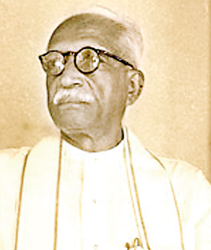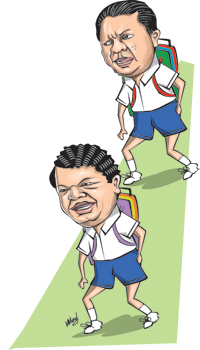Free education: The pearl of great price or pearls before swine
Again, the kingdom of heaven is like unto a merchant man, seeking goodly pearls: Who, when he had found one pearl of great price, went and sold all that he had, and bought it. (St. Matthew 13, 45-46.)
This striking biblical parable that our first Education Minister C. W. W. Kannangara echoed in his stirring address to the State Council exhorting his fellow legislators: “I say that Free Education is the answer. I say that it is a pearl of great price. Sell all that you have and buy it for the benefit of the whole community… Mankind has struck its tents and is on its onward march… Let us not lag behind.”
He continued:
“It was the proud boast of Augustus that he found Rome of brick and left it of marble. May I venture … to conclude this address with the flattering but just remark that the State Council of Ceylon found education dear and left it free, that they found it a sealed book and left it an open letter, that they found it the patrimony of the rich and left it the lasting inheritance of the poor.”
The Father of Free Education died on September 23, 1969, aged 85, and in poverty — unusual and unheard of for a Sri Lankan politician. One wonders whether the spirit of one of Sri Lanka’s greatest patriots would rejoice or grieve.
Rejoice his spirit must over the grandeur and nobility of the fruits of his epoch-making pearl of great price and the momentous educational accomplishments of the country.

C.W.W. Kannangara
Rejoice indeed that education that was “the patrimony of the rich is the inheritance of the poor” through the democratisation of school and university education.
Rejoice also that a network of central schools opened the doors of educational opportunity for both boys and girls of the rural population. Education in the rural schools through Madhya Maha Vidyalayas and Maha Vidyalayas came of age. They grew not only in quantity but also in quality as centres of excellence from three at the end of 1941 to 51 in 1945. They lured some of the best teachers from the denominational schools.
Their gain was the assisted schools’ loss. The new central schools opened the door to higher education and lucrative employment in the professions. Flowers born to blush unseen and waste their sweetness blossomed out from Akurambada to Wanduramba, from Kekirawa to Kuliyapitiya, to enrich the country’s human wealth, its intelligentsia and academia and professionals, and placed Sri Lanka in the front rank of literate nations of the world.
The spirit rejoicing is one part of the story of free education; the other part is the spirit grieving.
Grieve Kannangara’s spirit must over the travesty that has been made of his free education dream as witnessed by the mushrooming of unregulated international primary and secondary schools and private tertiary institutes of education where education is far from free and is the “patrimony of the rich”.
Grieve over a burgeoning private tuition education industry, in which both pupils and parents have placed greater trust than in school education and a former kingpin of which is — in a time warp— the present Minister of Education.
Grieve he must also that his “pearl of great price” that turned into “an apple of discord” from the time it was bought and with time grew into a gloomy thicket of embittered quarrels and disputes.
Grieve that children in frantic pursuit of examination-centred education are sacrificing the joys of childhood and of being a child before the altar of preparation for adulthood in an unknown future.
Grieve also that the momentum of his scheme has been blunted by the blustering and blundering words and actions of his current successors to the hallowed portfolio for education leading to manifold crises, a few of which are: the recent Z score fiasco that drove Advanced Level students to seek the intervention of the Supreme Court for redress; the paucity of competent and worthy principals and teachers, a few of whom have even been charged with rape and pornography, their pupils being the hapless victims; blatant politicisation of appointments in the education sector and admissions to Grade 1; the closure — also ironically — of rural schools; the long drawn out trade union action by university academics and other staff that have left our universities not “more open than usual” but often closed.
Not merely grieve but be outraged by recent insidious attempts at militarisation of education with grave implications for academic freedom and institutional autonomy.
Grieve too that Calibans of our day and age are, in a manner of speaking, saying
“You taught me language; and my profit on’t
Is, I know how to curse. The red plague rid you
For learning me your language!”
One is tempted to ask the wicked question whether Kannangara’s “pearl of great price” turned into “pearls before swine”.
Is this why D. H. Lawrence in the most dramatic fashion said that “the vast majority of our people should never learn to read and write, never” and T. S. Eliot said less harshly, “We insist upon ‘educating’ too many people; and Heaven knows what for”? He wrote in “The Aims of Education”:
“What I wish to maintain is a point of view from which it appears more important — if we have to choose, and perhaps we do have to choose — that a small number of people should be educated well and others left with only a rudimentary education, than that everybody should receive an inferior quality of education, whereby we delude ourselves into thinking that whatever there can be the most of, must be the best.”
Educationists of renown assert that Lawrence and Eliot were the only two twentieth century writers who had anything of fundamental importance to say about education in their times.
All in all, the glory and the freshness of the Kannangara dream has been turned into a nightmare of gloom and weariness and one begins to wonder if the Sinhala phrase nidahas adhyapana is a mistranslation of the English, with “free” connoting the freedom to destroy.
PS: The heart-rending picture on the front page of the Sunday Times of September 10, 2012, titled “Education in Tatters, Student in Tears”, tells the story of grief better than a thousand words. The caption read: With the higher education sector virtually breaking down, this heartbroken university student is seen in tears as his plea to the University Grants Commission to resolve the issue was stopped by the police who fired water cannon at them. Pic by Amila Gamage
Follow @timesonlinelk
comments powered by Disqus

























